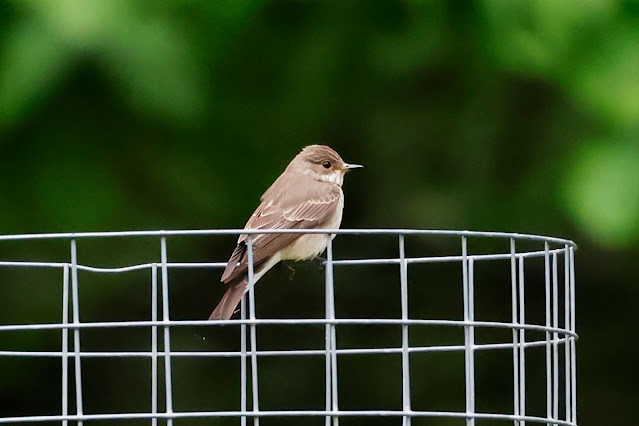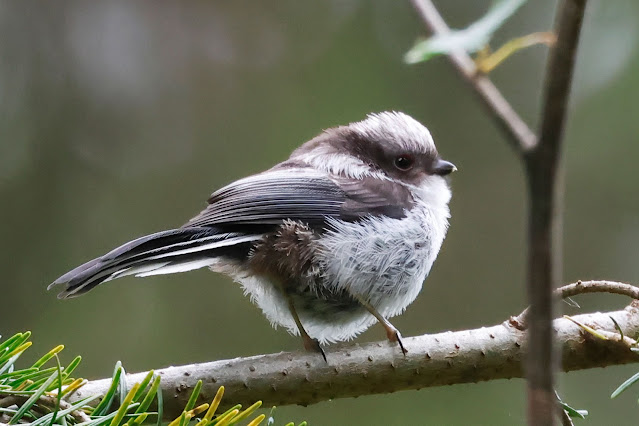We have now entered that period of the year where things become quiet on the birding front. It is a time though to catch up on some of the birds that call Hampshire home during the spring and summer and were missed earlier in the year.
Today I was looking once again for the Wood Warbler, a bird that has declined quite quickly in the county, but they are about in the expanse of the New Forest. I decided to try the area I had seen one last year, but as I pulled up in the parking area at the Canadian War Memorial the place was covered in red and wite tape and signs indicating that forestry work was taking place and the trail was closed for cycling.
I decided to walk the path to see if there was anything about but a short way down the path I came across the area where the Wood Warbler was singing this time last and I knew immediately that there was no hope in hell of finding one there today.
Cut logs piled up in exactly the area and signs of heavy vehicle use, no sane Wood Warbler would sing here.
A little further along there was a very cute foal staying very close to its mother as I walked by.
I walked all the way to Highland Water, with trucks and land rovers passing me. I could hear Firecrest singing and saw several Son Thrushes, but nothing that I was hoping for. I turned back and decided to try the Bolderwood area on the other side of the road I parked and headed out along the longest trail from the car park. Once again I could hear Firecrest singing on both sides of the path.
Approaching a clearing I noticed a small bird perched on one of the wire cages protected planted trees. It was a Spotted Flycatcher.
As I tried to get a little closer it flew off around the corner and I couldn't find it again. I could though hear their calls but never managed to see them.
I followed the trail, coming across singing Redstart and some Goldcrest. As the path dropped down a valley heading towards a stream I stopped to watch a family party of Long-tailed Tits.
There was a bridge over a small stream and as I approached a male Grey Wagtail came up from the stream bed.
The trail loops around and came back on itself, I passed another open area with calling Spotted Flycatcher, but nothing clearly visible. I reached a spot where there were several Firecrest singing and managed to get some great views of one as it clearly wasn't happy with the other birds around it.
A close up of that Fire Crest.
There were some wonderful backgrounds to frame this beautiful little bird.
Finally deciding to sing from the top of the nearby Spruce.
It was partially cloudy by now with some sunshine about, so I decided to head back to Pig Bush, to see if I could get some better views of the Honey Buzzards. The morning had been a big waste of time in my search for Wood Warbler, I think I now have to give them up for the year.
From the Pig Bush car park I walked through the woods and passed a group of birds with scope pointing towards th line of trees in the distance. The report was that there had not been a Honey Buzzards seen so far. I decided to walk around to the ridge where there is a better view point across the distant woods. Walking along the path a male Stonechat showed really well alongside the path.
As I reached the ridge the message came in "Nightjar in oak tree at Pig Bush" well that narrowed it down a little. Fortunately I was able to call the finder and he was still with the Nightjar and gave me directions to the said Oak tree. I retraced my steps and then headed to the area on the left hand side of the car park wood and crossed the open heath to another wood. It didn't take long to find the tree as there were two persons present.
It turns out that Graeme had been told by another walker that there was a Great Spotted Woodpecker nest close by and when he went to have a look he heard the churring call of a Nightjar and after establishing it did not come from the bracken he searched the tree and eventually found one Nightjar, this one, probably the hardest one to see.
A closer look, barely awake.
He didn't find the second bird until someone arrived with a thermal imaging camera, but it turns out this was in fact the easiest to see, it was paler than th efirst birst but still dead still on the branch.
Going back to the first bird there was a little more activity, the eye open a little more.
I have seen Nightjar in flight, heard them calling and flushed them from bracken. I have always wanted to get the opportunity to photograph one sitting on a branch, and here today there were two.
Here the position of the second bird, perfectly posed on a branch of the Oak tree.
Mysterious and elusive, the nightjar is one of our most
intriguing birds. A summer visitor with bark-like plumage, as you can see, it
can be incredibly difficult to spot.
This unusual-looking bird has an enigmatic appearance, with
perfectly camouflaged, grey-brown mottled plumage that resembles the bark of a
tree. A similar shape to a kestrel, the nightjar has a distinct pointed tail, a
flat head, large dark eyes and a small yet wide bill.
Males have bright white patches on the tips of their wings
and tail which are flashed when displaying to other males and females.
The nightjar’s diet is made up of invertebrates, including
moths, flies and beetles. It is nocturnal and spends its nights hunting for
food, catching it on the wing thanks to its wide mouth and silent flight.
The birder with the thermal imaging camera watches them regularly and said that they use the oak tree for roosting until the Bracken has grown tall and thick enough, when they move from the tree to breed.
They usually breed from late May to August. They do not
build a nest, instead laying eggs directly on the ground, where their bark-like
camouflage helps them resemble a log. They lay approximately two eggs, and
usually have two broods while in the UK. After around 20 days the chicks hatch,
fledging a couple of weeks later.
A Cuckoo had been calling for most of the time we were watching the Nightjars, then the calls became louder, then the Cuckoo flew past and called. I walked forward to see if it was perched in the open and it was but I managed just one shot before it flew off. It was though one really good image, my best since Colin the Cuckoo in Thursley.
Then it was back to the Nightjars. They would shuffle about on the branch and this would lead to them calling.
the wind blowing the feathers about.
Probably the widest any eye was open!
Here you get some idea of the size of the Nightjar and the long tail that can make them olook falcon like.
Traditionally, nightjars have been divided into two
subfamilies — the Caprimulginae, or typical nightjars with 79 known
species, including the Frogmouths I saw in Australia and the Chordeilinae,
or nighthawks of the New World, with 10 known species. The groups are
similar in most respects, but the typical nightjars have rictal bristles,
longer bills, and softer plumage. Their soft plumage is cryptically
coloured to resemble bark or leaves, and some species, unusual for birds,
perch along a branch rather than across it, helping to conceal them during the
day. The subfamilies of nightjars have similar characteristics, including small
feet, of little use for walking, and long, pointed wings.

Having watched the two Nightjars for over two hours and really chuffed to bits we decided to move on, and headed away and walked towards the copse by the railway line. Back in April we had seen Redstart here and they were still around, as we approached we could hear them singing. As well as the Redstarts there were Spotted Flycatchers calling and showing very briefly, but it was the Redstarts that showed well, Here a male in a birch tree.


This a female having caught a Blue-tailed Damselfly, a first of the year for me!
But of course it is the male that stands out one of our highly coloured summer visitors.
I thought I had my best Redstart photographs earlier in April, but these two really exceed them.
The female again, this time with a grub.
Walking back we made it across the mud and over the stream, on the ridge I turned to scan back over the trees and picked out two raptors with flat wings when soaring. Fortunately there was a scope at hand and this confirmed they were both Honey Buzzards one a pale phase male. They soared on the thermals and unfortunately drifted away even further from us. At one point they were joined by a Goshawk, also soaring on the thermals.
Back in the car park, at last a Spotted Flycatcher showing very well and not high above me for once
A day that up to about 10.00 am was looking like a complete disaster was turned around. Finally I have managed to see and even photograph a Nightjar at rest and in the open, then probably my best ever photographs of Redstart and Spotted Flycatcher.































































































